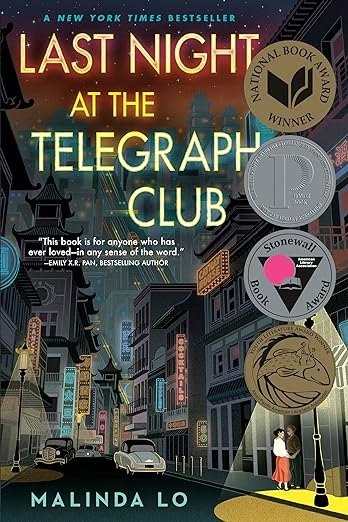Last Night at the Telegraph Club
Malinda Lo
Dutton Books for Young Readers
Published January 19, 2021
Amazon | Bookshop | Goodreads
About Last Night at the Telegraph Club
“That book. It was about two women, and they fell in love with each other.” And then Lily asked the question that had taken root in her, that was even now unfurling its leaves and demanding to be shown the sun: “Have you ever heard of such a thing?”
Seventeen-year-old Lily Hu can’t remember exactly when the question took root, but the answer was in full bloom the moment she and Kathleen Miller walked under the flashing neon sign of a lesbian bar called the Telegraph Club.
America in 1954 is not a safe place for two girls to fall in love, especially not in Chinatown. Red-Scare paranoia threatens everyone, including Chinese Americans like Lily. With deportation looming over her father—despite his hard-won citizenship—Lily and Kath risk everything to let their love see the light of day.
Why I Read Last Night at the Telegraph Club
Last Night at the Telegraph Club has been on my reading list for a long time. It was recently banned where I live, along with several other books. I’m trying to prioritize being educated about the content in books banned here in Florida, so that pushed this one up to the top of my reading list.
One of the things that’s really frustrating to me is that the committee that banned the book acknowledges the literary worthiness of the story and the importance of the topic. They simply object to a few paragraphs in the overall text and therefore are banning the book for all grades.
Review
The book primarily takes place in San Francisco in the 1950s, but includes historical information about a few events from the 1930s to the 1950s. Some scenes show what happened between Lily’s parents or from her aunt’s point of view. It shows the progression of the fear of and persecution of communists and those accused of being communist sympathizers. It also examines the cultural attitudes during that time period toward Chinese immigrants and Chinese Americans and attitudes about LGBTQIA+ people, especially women.
The background information feels very well-researched. Some characters’ experiences and backgrounds were inspired by Malinda Lo’s family’s lives. She includes, for example, the story of a Chinese man from a wealthy family who immigrates to the United States for college. He later serves in the military as a doctor.
I love that Lily is interested in rockets and math. The story references women working as computers and some of the efforts to develop technology to take humans into space.
So there’s a ton of really cool background to the story.
Lily and another girl also visit a nightclub several times to see a male impersonator perform. There, they meet other lesbian women. The story clearly shows Lily’s personal journey understanding her identity. Part of that recognition comes from when she reads parts of a sultry romance novel she finds at a drug store.
As Lily falls in love for the first time, and meets other women who love women, she finally feels like she can be herself. Like she’s not alone, and she doesn’t have to be ashamed.
There are so few historical books centering LGBTQIA+ stories, and yet queer people existed throughout history. I love seeing this sweet love story that openly explores what it might be like to be a Chinese American girl in the 1950s who is in love with another girl and wants to build rockets someday.
Parts of the story were hard for me to read. (They were meant to be so.) The number of people who ask Lily if she speaks English, or assume she doesn’t is astounding. And yet, I’m sure that experience is very real– and even more frustrating to experience in person.
The romance between Lily and Kath blooms slowly, but it blooms powerfully, too. Their desperation and their understanding of what could happen if they’re discovered is palpable.
Conclusion
If you’re looking for a sweet romance with a strong side of history and 1950s American culture, definitely put Last Night at the Telegraph Club on your reading list.
Content Notes
Recommended for Ages 16 up.
Profanity/Crude Language Content
None.
Romance/Sexual Content
Kissing and touching above the waist. Brief/vague description of masturbation. Brief description of sex with sparse details. In one scene, an adult woman approaches a teen and it seems like something could happen between them, but she recognizes the girl’s age and backs off.
Spiritual Content
Vague references to church.
Violent Content
Situations of peril. Homophobic comments.
Drug Content
Characters drink alcohol at a party and night club. Some characters smoke cigarettes. Reference to drug use (not shown on scene.)
Note: This post contains affiliate links, which do not cost you anything to use but help support this blog. I borrowed a copy of this book from my library. All opinions are my own.
